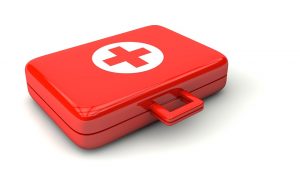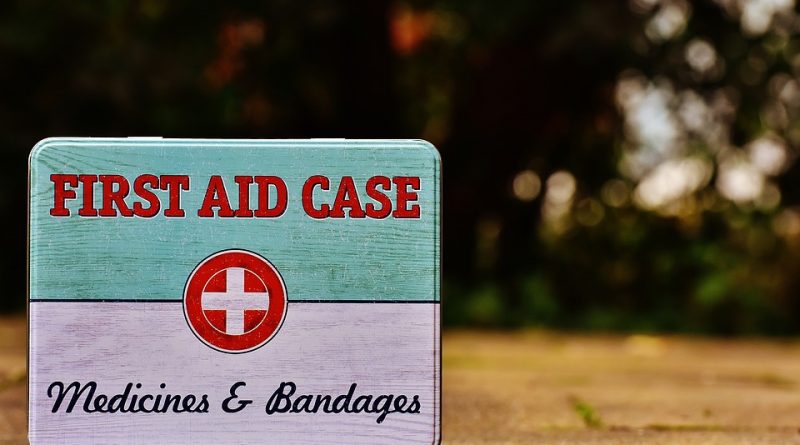Top 10 Pet First-Aid Kit Supplies for RV Travel
As a full-time RVer, I want to always have a pet first-aid kit available just in case our pets need minor medical care before we can get them to a veterinarian. These top ten supplies for a pet first-aid kit are recommendations from the American Veterinary Medical Association, as well as some RV-specific suggestions from members of our Tires And Tails Facebook Community, and can help if that situation ever arises.
The Top 10 Pet First-Aid Kit Supplies for Travel
- A copy of your pet’s medical record. Include a list of medications and dates of vaccinations. Add your pet’s veterinarian contact information as well as the Animal Poison Control Center number at 888-426-4435 (charges may apply). As soon as you arrive in or near a town, look up the numbers and addresses of emergency vet clinics at MyVeterinarian.com and post it where it can be easily accessed.
- An extra leash. Keep an extra leash in the kit for moving your pet if it can walk without injuring itself further.
- A muzzle. While it is injured, you may need to muzzle your pet and/or cover its head to prevent it from hurting you or itself even more. Items like gauze, a necktie, soft cloth, nylon stocking or small towel can be used in the place of a commercially made muzzle. Never muzzle an animal that is vomiting.
 A digital thermometer and water-based jelly. The type of thermometer you need is a fever thermometer. Pet temperatures are too high for a regular thermometer as their scale doesn’t go high enough. The jelly is to lubricate the thermometer before insertion. Pet temperatures should ONLY be taken rectally.
A digital thermometer and water-based jelly. The type of thermometer you need is a fever thermometer. Pet temperatures are too high for a regular thermometer as their scale doesn’t go high enough. The jelly is to lubricate the thermometer before insertion. Pet temperatures should ONLY be taken rectally.- Hydrogen peroxide. A 3% solution of hydrogen peroxide is used to induce vomiting. Use ONLY after contacting a veterinarian or the Animal Poison Control Center first (888-426-4435 charges may apply). Follow the vet’s or poison control center’s instructions for dosage.
- Nonstick bandages, strips of clean cloth or towels, and/or Vet Wrap. For wounds that are bleeding or need to be protected, use these items.
- Adhesive tape for bandages. This is to keep any gauze wrap or bandages securely in place around a wound.
- An eyedropper, turkey baster, and/or large syringe (no needle). These are used for administering oral medications or treatments (inducing vomiting) and/or flushing wounds.
- Prescription medications for your pet. Have a few days worth of your pet’s prescription medications as a back-up in case you run out. This includes any pain medication your pet has used previously.
- A stretcher. In most cases people will not go out and buy a stretcher just for their pets. So, in case of an emergency, keep on hand a board, blanket, towel, or floor mat that could be used as a stretcher to safely transport your pet from one location to the next. It can be quite difficult to lift large dogs without one.
Additional Items for Your Pet First-Aid Kit

The following items are also useful to keep in your pet’s first-aid kit. Please keep in mind that cats and dogs CANNOT always use the same medications. Consult with your veterinarian before giving ANY human, over-the-counter medications to your pets.
- Tweezers
- Tick removal tool
- For motion sickness: Meclizine (Dramamine II, Bonine, Antivert)
- For general upset stomach: Bismuth subsalicylate (Pepto Bismol in liquid or tablet form), Pepcid AC, Zantac
- In case of diarrhea: Immodium AD, metronidazole (by prescription)
- Benadryl for allergic reactions
- Styptic powder or pencil, or cornstarch to stop bleeding after nail trims
- Eye drops/eye wash
- Baby aspirin
- Antibiotic cream
- Saline solution for cleaning wounds
- Antiseptic wipes, lotion, or spray
- Cotton balls or swabs
- Non-latex disposable gloves
- Scissors with blunt ends
The above lists are to help you be more ready in the event that your pet is ever in a medical emergency. They are not a substitute for actual veterinary care, but can buy you time until you can get your pet to a vet clinic. Keep your pet’s first-aid kit handy and fully stocked. It will give you the peace-of-mind you’ll need as you travel with your furry friends.
Please share your experience with putting together a first-aid kit for your pets
- What do YOU put into your pet’s first-aid kit?
- Did we leave out any critical items?
Let us know in the comments below, or submit a story we can share in our community story post!



